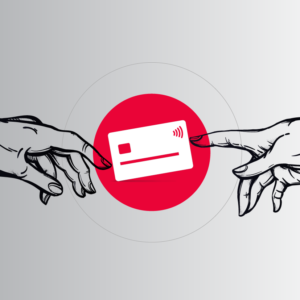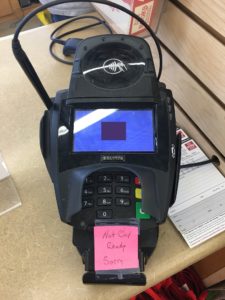
This past weekend, I took my son to the movies at a multiplex cinema in Austin, Texas. Like several other merchants, they still do not accept EMV chip cards. A small sign is taped over the card slot on all the readers throughout the theater: “No chip cards”.

When the tender is totaled, the terminal displayed two options: Swipe or Tap. Meaning, you can swipe your card the “old-fashioned way”, or tap-and-pay with a mobile wallet or contactless card.
To me, the sign provides some evidence of the success of the EMV migration. Consumers have been conditioned to dip their cards, instead of swipe. Without the sign taped over the slot, they would naturally insert their cards. They also know what a “chip card” is.
And yet, you still cannot dip at many places. And at the locations where you can dip, the wait is inconsistent. I counted 11 seconds before I could remove my card at one of the largest hypermarkets in the country.
So twelve months after the EMV liability shift, to help us understand the current state of EMV, we’ve invited James Wester, Research Director for IDC Financial Insights, to share his perspective.
In this guest blog series, James Wester talks about what’s been achieved, what’s still to be done, and what’s next for the U.S. payments market.
WHAT COMES AFTER EMV?
by James Wester
Leading up to last October’s EMV deadline, I retained some hope that the U.S. market’s migration to chip-enabled cards would be smooth. Instead, merchants experienced delays and expense, issuers faced criticisms, and consumers found their experience at the point of sale had become worse.
A year later, things are improving in many ways: more chip cards have been issued, more merchants are accepting them, and more consumers are getting used to using them. Some data worth considering:

- 87% of U.S. consumers regularly report using chip-enabled cards
- 88% of MasterCard-branded consumer cards are now chip-enabled
- 326 million (42%) of Visa-branded cards are chip-enabled
- 2 million U.S. merchants, or about one-third are now able to accept chip-enabled cards
Even the process at the point of sale is improving as consumers become familiar with chip cards. It’s not the speed of a swipe, but it’s better.
Best of all, both MasterCard and Visa are reporting that chip cards are reducing counterfeit card fraud as intended. Visa reported a 47 percent decrease in fraud compared to the same month last year. And MasterCard said April saw a drop in fraud of 54 percent versus the same month last year.
NOW WHAT? SPEED IT UP!
The issue before the payment industry at this point is what comes next? Consumers are becoming accustomed to a payment experience that is still slower and more cumbersome—albeit more secure—than what they were used to. In a world where consumer experiences almost uniformly improve with each new technology, why is payments taking a step backwards?
For issuers and their cardholders, the answer to that last question is that it doesn’t have to be that way. Because of what comes next: contactless EMV payments.
Contactless, or tap-and-pay, cards give consumers the same security as an EMV transaction, but transmit the information with a wave of the card. There is no more inserting, less waiting, and no concern about leaving the card in the POS terminal. Transaction times are reduced from 7 to 10 seconds down to nearly instant.
Along with a faster transaction time, contactless cards lack a learning curve: consumers don’t have to learn a new process, load any information or involve another device. And unlike mobile payments, the form factor is the same as their regular plastic card but with the ability to tap, pay and be on their way. Plus, the technology required to accept contactless payments is already in market thanks to the EMV transition.
CONTACTLESS CARDS ARE A BOON FOR ISSUERS
While not a new technology, contactless has increased in popularity in many markets. In the U.K., contactless cards have grown from around 50 million cards issued in September 2014, to just under 100 million contactless cards. With that doubling of cards in the market, spending on those cards has increased nearly nine times—from £250 million to more than £2.2 billion. For issuers, that means more spend on those cards.
As issuers strive to deliver a better experience to their cardholders to gain top-of-wallet status, we’re beginning to see more U.S. issuers offer “dual-interface” cards capable of both insert as well as tap-and-pay chip transactions. New Costco cards issued by Citi are a prominent example. However, those numbers are still small, and issuers have much to gain from a first-mover advantage in providing a better, faster experience to cardholders.
The hard part of the EMV transition is over, but in its place we’re left with a feeling that the payment experience could be better. The good news is that contactless offers a better experience, one that leverages the earlier efforts and investment made during the transition to chip cards. Now it’s just a matter of issuers deciding to take advantage of that ‘something better’.


